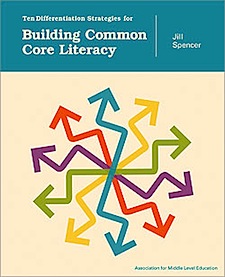Ten Differentiation Strategies for Building Common Core Literacy
Ten Differentiation Strategies for Building Common Core Literacy
By Jill Spencer
(Association for Middle Level Education, 2013 – Learn more)

When teachers hear Common Core and differentiation, they are frozen with fear and questions about what to do. Jill Spencer’s Ten Differentiation Strategies for Building Common Core Literacy is a warm breath of fresh air to teachers who wish to differentiate in their classrooms using the Common Core Standards.

Reading Strategies
1. When Everyone Must Read the Same Text
2. Providing Less Able Readers Access to Rich Curriculum Materials
3. Building Skills to Cite Evidence
4. Silent Sustained Evidence
Writing Strategies
5. Everyone Writing the Same Essay or Response
6. Supporting Less Able Writers: Student Voice and Choice
7. Building Grammar Skills and Clear Communication
8. Rehearsal Strategies for Success in Writing
Strategies for Both Reading and Writing
9. Meeting the Literacy Needs of Young Adolescent Males
10. Synectics: Sparking Creative Thinking
Throughout the book Spencer uses these 10 strategies to show teachers how to differentiate in their classrooms. She includes step-by-step procedures on how to implement each strategy as well as many examples of how these strategies can be used in other content areas.
A book for teachers in all content areas
The title of the book does not do justice to the real potential it holds. It is a useful tool for teachers in all content areas, but it may be overlooked by teachers of other subjects due to the literacy focus in the title. When other teachers see “literacy,” they most often assume that a book is geared toward English language arts. In keeping with the Common Core vision, Spencer has focused her advice on how to differentiate student instruction using strategies that recognize the literacy component found in every subject, across the curriculum. If the book carried a title like Ten Differentiated Strategies for Common Core Implementation, perhaps it would pique the interest of more teachers.
That said, Ten Differentiation Strategies for Building Common Core Literacy is a great tool that I hope will get into the hands of many teachers, department chairs and instructional leaders who can alert colleagues to its usefulness. Spencer includes numerous resources — websites, rubrics, handouts, and lessons — as well as step-by-step instructions on how to implement each strategy. She also explains the Common Core standards in easy terms that novice and veteran teachers can comprehend and apply.
I highly recommend this book. Classroom teachers and prospective teachers who are overwhelmed with Common Core and/or differentiation should read it. It is chock full of information on how to meet the needs of all students. At the same time, it breaks down the big ideas behind the Common Core standards and identifies the best teaching strategies to meet the Common Core challenge.
As a college-based teacher educator, I plan on using these strategies when teaching prospective teachers because of the easy-to-follow format and explanations.
Casey Gilewski is from Memphis TN and is currently a doctoral student and graduate teaching assistant. She has taught in public schools for six years – one year in second grade, five in sixth, and two in seventh and eighth. Throughout her public school experience, she has taught English language arts and special education and has served as grade chair and on Common Core committees. Her doctoral dissertation focuses on differentiated instruction and assessment.




























